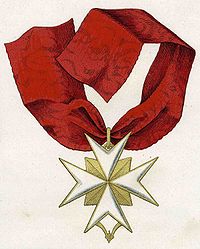Order of the Golden Spur
| Order of the Golden Spur Ordo Militiae Auratae |
|
|---|---|

Scan from the Book of Orders at the Archdiocesan Library Cologne
|
|
| Awarded by The Pope |
|
| Type | Chivalric order |
| Status | Currently constituted |
| Sovereign | His Holiness Pope Francis |
| Grades | Knight |
| Statistics | |
| Established | ca. 332? |
| Precedence | |
| Next (higher) | Supreme Order of Christ |
| Next (lower) | Order of Pius IX |
|
Ribbon bar of the order |
|
The Order of the Golden Spur (Italian: Ordine dello Speron d'Oro, French: Ordre de l'Éperon d'or), officially known also as the Order of the Golden Militia (Latin: Ordo Militia Aurata, Italian: Milizia Aurata), is a Papal Order of Knighthood conferred upon those who have rendered distinguished service in propagating the Catholic faith, or who have contributed to the glory of the Church, either by feat of arms, by writings, or by other illustrious acts.
It is accounted the earliest papal chivalric institution. The Order of the Golden Spur had its origins in the title Count palatine of the Lateran Palace, which was in the gift of the Holy Roman Emperor in the fourteenth century: Charles IV, Holy Roman Emperor conferred the title on one Fenzio di Albertino di Prato, 15 August 1357, at Prague. The Order began to be associated with the inheritable patent of nobility in the form of count palatinate during the Renaissance; Emperor Frederick III named Baldo Bartolini, professor of civil law at the University of Perugia, a count palatinate in 1469, entitled in turn to confer university degrees. "Bartolini also received the Knighthood of the Golden Spur, a title that sometimes accompanied the office of count palatinate in the Renaissance", according to the historian of universities Paul F. Grendler; the Order of the Golden Spur, linked with the title of count palatinate, was widely conferred after the Sack of Rome, 1527, by Charles V, Holy Roman Emperor; the text of surviving diplomas conferred hereditary nobility to the recipients. Among the recipients was Titian (1533), who had painted an equestrian portrait of Charles. Close on the heels of the Emperor's death in 1558, its refounding in Papal hands is attributed to Pope Pius IV in 1559.
...
Wikipedia
